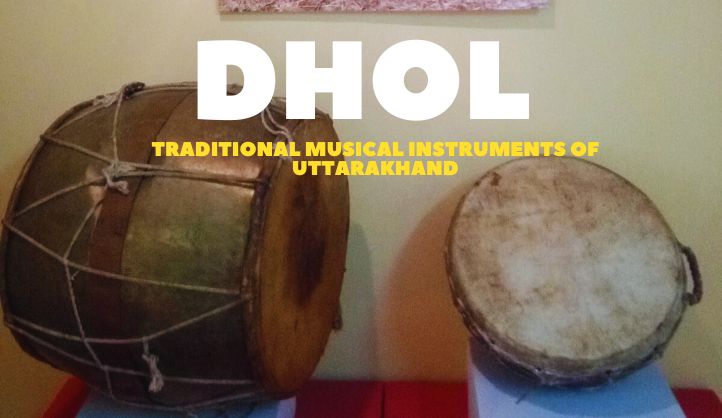Nestled in the majestic Himalayas, Uttarakhand is a state brimming with cultural richness. Its folk music, vibrant and alive, pulsates with the rhythmic beats of the Dhol, a double-headed drum that serves as the very heartbeat of its traditions. More than just an instrument, the Dhol is an integral part of the social fabric of Uttarakhand, weaving its powerful sounds into the tapestry of everyday life, from joyous celebrations to solemn rituals.
A Legacy Carved in Wood and Skin
This musical instrument boasts a simple yet robust construction. Traditionally crafted from seasoned wood like mango or deodar, its body is shaped like a barrel with two heads made from animal skin, usually goat or sheep. The heads are stretched taut and secured using a web of ropes or leather straps. These straps can be tightened or loosened to alter the pitch of the drum.
The Dhol player, known as a Dholwala, carries the instrument slung over one shoulder with a broad strap. Two sticks, often made of bamboo or cane, are used to strike the heads, producing a deep, resonant sound that can vary greatly depending on the technique employed. Skilled Dholwalas can manipulate the sticks to create an impressive repertoire of beats, ranging from slow and solemn to frenetic and celebratory.
A Dhol for Every Occasion
This musical instrument is not merely a decorative piece, it is a vital participant in Uttarakhand’s social and cultural life. From the cradle to the grave, its rhythmic presence accompanies the state’s people through every significant milestone. Here’s a glimpse into how the Dhol resonates with different occasions:
- Festive Celebrations: This musical instrument is the lifeblood of festivals like Harela, Holi, Diwali, and Navratri. Its energetic beats set the mood for revelry, adding a pulsating rhythm to joyous dances and vibrant processions.
- Weddings: This musical instrument heralds the arrival of the groom’s procession, creating a celebratory atmosphere that welcomes the new bride into her new home.
- Folk Performances: This musical instrument plays a pivotal role in Uttarakhand’s vibrant folk music scene. It provides the foundation for lively dances like the “Langvir” and the “Bhaat,” and accompanies the soulful melodies of instruments like the “Ransingha” and the “Flute.”
- Religious Ceremonies: This musical instrument’s presence extends to religious ceremonies as well. Played with a slower tempo and more restrained strokes, it lends a sense of solemnity to pujas and rituals.
- Communication: In bygone eras, this musical instrument served as a unique communication tool in the mountainous regions of Uttarakhand. Specific rhythmic patterns passed down through generations, could convey messages of danger, celebration, or even announce the arrival of a visitor.
There’s an almost mythical quality associated with this musical instrument in Uttarakhand. An ancient oral treatise known as the “Dhol Sagar” lays out specific rhythmic patterns for various occasions. Traditionally, the knowledge and skill of playing the Dhol have been passed down through generations within specific caste groups entrusted with keeping this cultural legacy alive.
The Dhol – Beyond Borders
The rhythmic magic of the this musical instrument transcends the boundaries of Uttarakhand. It is a prominent feature in the musical traditions of Himachal Pradesh, Nepal, and parts of North India. Each region imbues the Dhol with its unique stylistic nuances, reflecting the cultural tapestry of the Himalayas.
In recent times, the Dhol has found a wider audience. Renowned Indian folk music ensembles have incorporated its powerful beats into their performances, showcasing its versatility to a global audience. This musical instrument’s energetic and infectious rhythm has even found its way into contemporary music genres, adding a touch of earthy vibrancy to modern compositions.
Conclusion
The Dhol is more than just a musical instrument; it is a symbol of Uttarakhand’s rich cultural heritage. Its rhythmic pulse embodies the spirit of the state – vibrant, resilient, and deeply connected to its traditions. As the echoes of this musical instrument continue to resonate through the valleys and hills of Uttarakhand, it ensures that the state’s cultural legacy finds a voice in every beat.
FAQs About Dhol
1. What are some of the other traditional instruments played alongside this musical instrument in Uttarakhand?
The Dhol is often accompanied by instruments like the “Damau” (a smaller drum), the “Ransingha” (a large brass trumpet), the “Flute,” and the “Chimta” (a pair of tongs played for rhythmic effect).
2. Is this musical instrument difficult to learn?
Playing this musical instrument requires coordination, strength, and a good sense of rhythm. While the basic strokes can be learned relatively quickly, mastering the intricacies of the instrument and its vast repertoire of beats takes dedication and practice.
3. Can anyone buy a Dhol?
Dhols are readily available for purchase in instrument stores specializing in traditional Indian instruments. However, the quality and sound can vary greatly. For a truly authentic Dhol, it’s best to connect with local craftspeople in Uttarakhand who use traditional methods and materials to create these instruments.
4. How is the Dhol cared for?
The Dhol requires regular maintenance to ensure optimal sound quality and longevity. The animal skin heads need to be kept taut and free of moisture. After playing, it’s important to wipe down this musical instrument to remove any dust or sweat. Storing the Dhol in a cool, dry place away from direct sunlight is also crucial.
5. Where can I hear the Dhol being played?
If you’re visiting Uttarakhand, you’re likely to encounter the Dhol’s rhythmic presence during festivals, weddings, or folk performances in villages and towns. You can also find videos showcasing this musical instrument online or attend performances by Indian folk music ensembles that incorporate this musical instrument into their repertoire.





